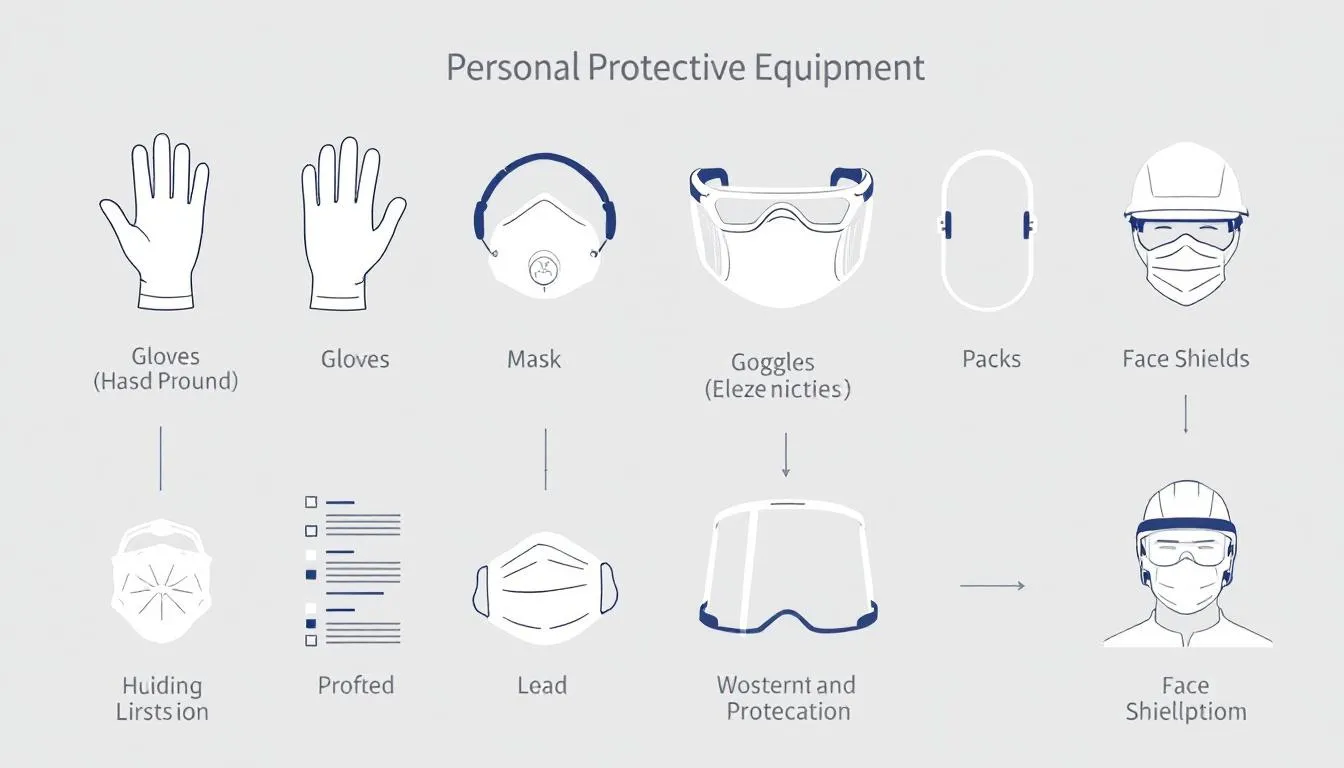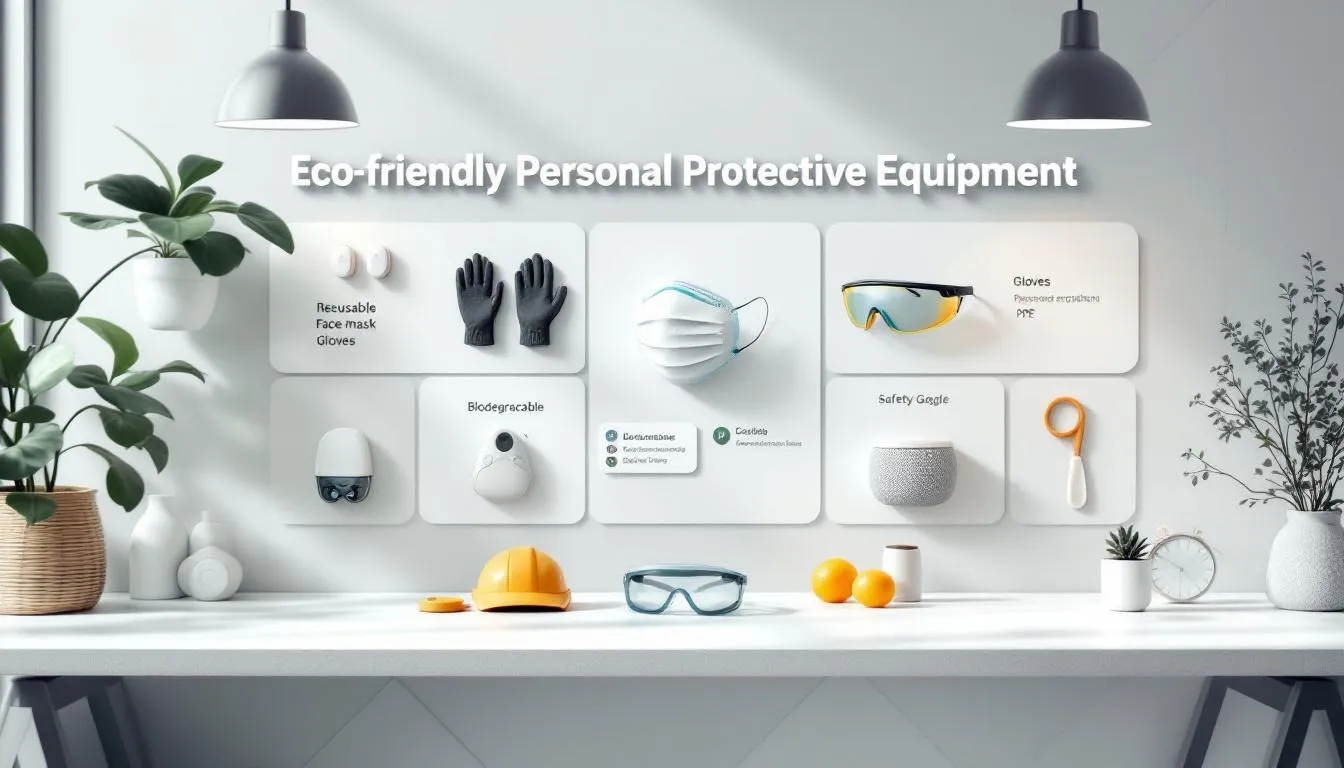Top-Quality PPE for Reliable Protection & Comfort
PPE, or Personal Protective Equipment, protects workers from hazards. It includes gloves, masks, and gowns. This article explains the types of PPE, how they protect you, and tips for choosing the right gear.
Key Takeaways
-
Personal Protective Equipment (PPE) is essential for workplace safety, providing crucial protection against various hazards and ensuring compliance with regulatory guidelines.
-
Choosing the right type of PPE requires thorough risk assessment, material consideration, and ensuring proper fit and comfort for effective protection.
-
Investing in high-quality and eco-friendly PPE not only enhances safety but also contributes to long-term savings, reduced insurance costs, and improved corporate reputation.
Understanding PPE: What It Is and Why It Matters

Personal Protective Equipment (PPE) encompasses a variety of tools designed to protect workers from diverse hazards, including:
-
Gloves
-
Masks
-
Face shields
-
Gowns Each serves unique protective functions. PPE acts as a barrier to minimize exposure to chemicals, noise, and physical injuries, thereby playing a crucial role in workplace safety. Regulatory bodies such as OSHA and the EU’s PPE Regulation 2016/425 have established guidelines to ensure employers provide adequate PPE to protect workers.
The responsibility of providing necessary PPE falls on employers, especially when other safety measures are insufficient. Proper selection and fitting of PPE are essential to maximize safety and prevent workplace injuries.
Understanding the importance of PPE is the first step towards creating a safer work environment. This section aims to clarify the indispensability of PPE and its role as a critical component in workplace safety protocols.
Types of PPE and Their Uses

The world of PPE is vast, encompassing a range of items designed to safeguard different parts of the body. These include:
-
Gloves
-
Safety glasses
-
Helmets
-
Respirators Each type of PPE serves a specific purpose. Understanding the different types of PPE and their uses is crucial for ensuring workers are adequately protected against various hazards.
This section covers the specific uses of gloves, masks, respirators, and face shields and goggles, as well as the details of their applications and benefits.
Gloves
Gloves provide essential hand protection against various hazards. Nitrile gloves, in particular, are known for their versatility and durability. Key features and uses include:
-
Made from synthetic rubber
-
Provide excellent chemical and puncture resistance
-
Suitable for users with sensitive skin or latex allergies
-
Ideal for tasks requiring a high level of dexterity and protection, such as handling chemicals or performing medical procedures.
Nitrile gloves are available in various colours, sizes, and thicknesses to suit different tasks:
-
Blue nitrile gloves are often used in healthcare settings to prevent contamination.
-
Thicker gloves offer superior protection in industrial environments.
-
The powder-free and latex-free nature of nitrile gloves makes them a popular choice for those with latex allergies.
Whether you need gloves for cleaning, laboratory work, or industrial applications, nitrile gloves provide the reliability and performance required to get the job done safely.
In addition to nitrile, other most popular material glove options include latex and vinyl. Latex gloves offer excellent elasticity and fit, but they may cause latex allergy reactions in some users. Vinyl gloves, on the other hand, provide a cost-effective option for tasks that require basic protection without the need for high durability.
When choosing gloves, it is essential to consider the specific requirements of your task and select the material that offers the best balance of protection, comfort, heat, and 100 gloves.
Masks and Respirators
Masks and respirators are critical for protecting the respiratory system from harmful particles and pathogens. Surgical masks are primarily designed to prevent the spread of respiratory droplets, making them essential in medical settings to protect both healthcare workers and patients.
On the other hand, N95 respirators offer a higher level of filtration, effectively blocking airborne particles and providing a higher degree of protection in manufacturing industries and environments with a high risk of airborne contaminants. In comparison, they are more resistant and effective than standard medium masks.
Choosing the right type of mask or respirator depends on the specific hazards present in your work environment. For instance, healthcare workers dealing with patients must use surgical masks to prevent contamination, while those working in environments with airborne chemicals or dust should opt for N95 respirators. Both types of respiratory protection are crucial for maintaining safety and compliance in various industries.
Face Shields and Goggles
Face shields and goggles provide essential protection for the face and eyes against splashes, particles, and harmful substances. Face shields offer full-face coverage, making them ideal for situations where there is a high risk of splashes or flying particles. They are commonly used in healthcare settings, laboratories, and industrial environments to provide added protection against contaminants. The face shield provides an additional layer of safety.
Goggles, on the other hand, are designed to typically protect the eyes specifically. They are particularly useful in environments where chemical exposure is a concern, as they provide a tight seal around the eyes to prevent any harmful substances from entering.
Both face shields and goggles are crucial for ensuring maximum protection and preventing injuries in various working conditions. Selecting the right eye and face protection is essential for maintaining safety and compliance with industry standards.
Choosing the Right PPE for Your Needs
Choosing the right PPE involves more than just picking items off a stock box shelf. It requires a thorough understanding of the risks in your workplace, the materials best suited to mitigate those risks, and ensuring the suits fit comfortably and securely.
Involving workers in the selection process can increase their awareness and likelihood of proper usage. This section will guide you through assessing risk levels, considering materials, and ensuring a proper fit for maximum protection.
Assessing Risk Levels
Effective PPE selection starts with a comprehensive risk assessment, which includes:
-
Understanding worker exposure to hazards, including the type, duration, and extent of exposure.
-
Regularly assessing PPE needs.
-
Providing training on the proper use of PPE to ensure compliance and safety.
-
Identifying specific hazards present in the work environment.
-
Understanding industry standards that dictate the necessary level of protection.
A thorough risk assessment helps determine if PPE is necessary and what type of PPE is required. It ensures that all potential hazards are addressed, and workers are equipped with the right tools to stay safe. Regular assessments allow employers to adapt to changing conditions and enhance workplace safety continually.
Material Considerations
Selecting the appropriate materials for PPE is essential for ensuring user safety and effectiveness in various environments. Different materials provide varying levels of protection, comfort, and durability, so it’s important to choose the right one based on the task at hand. Nitrile gloves, known for their durability and chemical resistance, are ideal for tasks requiring robust protection.
Material compatibility with the task and working environment should be a primary consideration when selecting PPE. This ensures that the equipment not only provides adequate protection but also enhances comfort, usability, and texture. Understanding the properties of different popular material enables informed decisions that enhance safety and efficiency.
Fit and Comfort
Proper fit and comfort are critical factors in the effectiveness of PPE. Ill-fitting equipment can increase the risk of exposure to hazards and reduce the overall protection it offers. When selecting extra large gloves, consider the following:
-
Measure the width across the palm.
-
Measure the length from the palm to the top of the middle finger.
-
If you are between sizes, size up to ensure a comfortable fit.
Gloves should:
-
Provide full coverage of the hand and wrist to protect against chemicals or hazards.
-
Have a snug fit to ensure dexterity and minimize the risk of tears, making it easier to perform tasks safely.
-
Be selected using the sizing chart to ensure the right size, providing maximum protection and peace of mind.
In addition to fit, the comfort of PPE plays a significant role in its effectiveness. Comfortable PPE encourages consistent use, reducing the likelihood of workers removing it due to discomfort. This is especially important for tasks that require prolonged use of protective equipment. By prioritizing fit and comfort, you can ensure that your PPE provides reliable protection without compromising usability.
Benefits of Using High-Quality PPE

Investing in high-quality PPE offers numerous benefits that extend beyond immediate safety:
-
Durable PPE requires less frequent replacement, leading to long-term savings and decreased operational costs for businesses.
-
Quality PPE often leads to lower insurance premiums, as providers link effective safety measures with reduced accident rates.
-
This not only protects workers but also contributes to the financial health of the company.
Using eco-friendly PPE offers several benefits:
-
Boosts a company’s reputation and employee satisfaction by showcasing a commitment to environmental responsibility.
-
Provides reliable protection with high-quality, sustainable options like biodegradable nitrile gloves.
-
Ensures safety, cost-effectiveness, and a positive corporate image by choosing top-quality PPE.
Maintaining and Disposing of PPE
Proper maintenance and disposal of PPE are vital for ensuring its effectiveness and reliability. Regularly checking for signs of contamination or wear is essential to maintain safety standards. Training on the correct use, maintenance, and disposal of PPE helps workers understand how to handle their equipment properly, ensuring it provides reliable protection.
When disposing of PPE, it’s important to follow guidelines to prevent contamination. If PPE has not been contaminated, it can be disposed of with general waste. However, contaminated PPE should be double-bagged and stored securely for 72 hours before disposal to minimize the risk of spreading infectious materials. Adhering to these practices helps maintain a safe and healthy work environment.
Eco-Friendly PPE Options

Eco-friendly PPE options are becoming increasingly popular as companies seek to reduce their environmental impact. Biodegradable nitrile gloves offer a sustainable alternative to traditional PPE, providing reliable protection while minimizing waste. These gloves break down more quickly in landfills, reducing their environmental footprint.
Buying nitrile gloves in bulk can also lead to reduced shipping emissions, less packaging waste, and cost efficiency, which can help save resources. Choosing eco-friendly options and purchasing in bulk demonstrates a company’s commitment to sustainability and high safety standards.
Compliance with Safety Standards
Compliance with safety standards is essential for ensuring the reliability and quality of PPE. Regulations like the CE and UKCA marks indicate that PPE meets defined health and safety standards, providing assurance of its effectiveness. Manufacturers must maintain a technical file that includes design specifications, risk assessments, and compliance evidence for regulatory inspections.
Eco-friendly certifications also indicate that PPE meets specific environmental standards, including sustainable materials and processes. Choosing certified PPE ensures reliable protection and adherence to high safety and environmental standards.
Where to Buy Reliable PPE

Finding reliable suppliers is crucial for ensuring the quality and safety of PPE products. Look for suppliers that specialize in a wide range of PPE products, including safety gloves, respirators, and protective clothing. Reputable retailers often have customer reviews and ratings that can help assess the quality of their offerings.
Discounts and bulk purchase options may be available from some suppliers, helping to reduce overall price costs for businesses. Selecting reputable suppliers ensures your PPE meets high safety and reliability standards, providing peace of mind for employers and workers.
Compare vsdent nitrile gloves with othe competitor
When comparing VSDent nitrile gloves with other competitors, several factors stand out:
-
Recognized for their durability
-
Designed to reduce the risk of allergic reactions compared to latex gloves
-
Offer superior strength
-
Provide excellent grip, making them ideal for a wide range of tasks.
Competitors may offer nitrile gloves that lack the same level of tactile sensitivity found in VSDent’s products. Pricing for VSDent nitrile gloves is competitive, often providing better value without compromising on quality. Additionally, VSDent gloves are available in various sizes, ensuring a comfortable fit for a wide range of users, which may not be the case with some competitors.
Overall, VSDent nitrile gloves provide enhanced barrier protection against chemicals and pathogens, making them a reliable choice for those seeking high-quality PPE. Choosing VSDent means investing in gloves that offer superior performance and value.
Summary
Investing in high-quality PPE is not just about compliance; it’s about ensuring the safety and well-being of workers. By understanding the different types of PPE and their specific uses, assessing risk levels, considering material and fit, and maintaining and disposing of PPE properly, you can create a safer work environment. High-quality PPE offers long-term benefits, including reduced costs and enhanced company reputation. Whether you opt for eco-friendly options or the superior protection of VSDent nitrile gloves, making informed decisions about PPE is crucial for reliable protection and comfort in any industry.
Frequently Asked Questions
What is the primary purpose of PPE?
The primary purpose of PPE is to serve as a protective barrier that minimizes worker exposure to hazards such as chemicals, noise, and physical injuries. This vital equipment is essential for ensuring safety in the workplace.
How do I choose the right type of gloves for my needs?
To choose the right type of gloves, assess the specific requirements of your task, focusing on factors such as chemical resistance, durability, and dexterity. Nitrile gloves are often recommended for their versatility and durability across various applications.
What are the benefits of using high-quality PPE?
Using high-quality PPE provides long-term savings from increased durability, lower insurance premiums, and an enhanced company reputation, especially when eco-friendly options are utilized. Prioritizing quality in PPE not only protects employees but also supports overall business sustainability.
How should I dispose of contaminated PPE?
Contaminated PPE must be double-bagged and securely stored for 72 hours prior to disposal. If it is not contaminated, it may be disposed of with regular waste.
Why is it important to comply with PPE safety standards?
Compliance with PPE safety standards is crucial because it guarantees the reliability and effectiveness of personal protective equipment, ensuring adequate protection for users. Certifications such as the CE and UKCA marks signify adherence to essential health and safety regulations.



Leave a comment